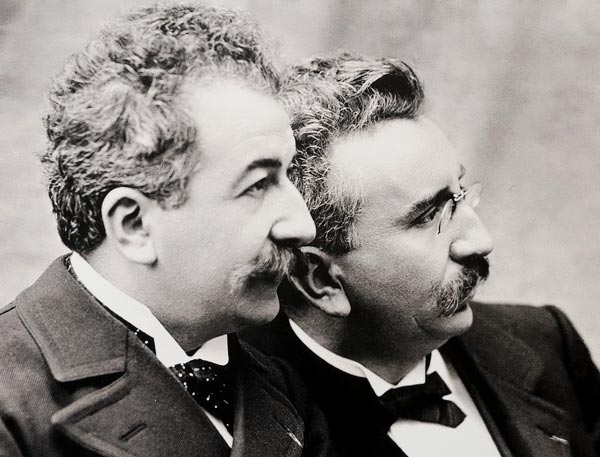Creativity, innovation, mash-ups, and science fiction writers… as a lens on lessons from the software industry.
Introduction
Here’s a preview of coming attractions:

I’ve got about 15 minutes. I’m going to talk about creativity, innovation, trains, large companies, hip-hop mash-ups, and science fiction writers.
And in the process, I’ll go into a few lessons the software industry has learned which might be applicable to other creative endeavors as well.
But let’s start where one should. At the beginning.
Innovation

Auguste and Louis Lumière were pioneers and innovators. They had several movie-related patents to their name, including the film perforations that survive to this day.
Their technical innovations extended beyond filmmaking. For example, they also invented color film technology and the color plate, making color photography portable.
In 1895 they had a crazy productive year.
In February they patented the first version of the cinématographe, which they had been working on for a couple of years. By March 19 they were recording footage, by March 22 were holding the first private showings, and before the end of the year they had a paid public screening of 10 shorts.
That’s an iteration speed most startups would wish they could keep up.
And the traction… Wow.
People hadn’t seen anything like it. They just ate up anything the Lumières would put out.
Just a few months later, in January 1896, they showed The Arrival of a Train at La Ciotat Station.
I’m not sure how many of you have seen this, so I’m going to give you a minute to appreciate it.
The stories go that the projection was so realistic that as the train in the movie approached the camera, people panicked, ran out.
Whether those are true or not is in dispute. I’m sure that the Lumières benefitted from rumors that their technology made things look so real that people were freaking out about it.
Make no mistake, they understood not only technology, but marketing. The previous year, they even had a hand in creating the world’s first film poster.
They created a medium… and then abandoned it.
In only a few years declared that “cinema is an invention without any future“ because (go figure) people got tired of just seeing single recorded scenes.
They were obviously, hilariously wrong. They were so convinced of it, that they even refused to sell their cameras to others.
That leads us to the first issue I want to discuss today.
Lesson 1: Having no idea
Let me posit this:
If you are truly innovating, chances are you have no idea what you're doing.
And maybe I shouldn’t put it in this way, given that in Samsung NEXT we pride ourselves in working with innovators, but I mean it in a good way. I swear.
If you are truly innovating, you are creating something for which there is no good parallel out there. You have no idea how your invention will work out in the wild. As Gibson said, “the street finds its uses for things”.
That’s why usually, it’s very rare to find an innovator who can right away see the implications and ramifications of their innovations.
What you create is important. But what really matters is how you, or others, use it.
It's not about the gadget, but about what you make out of it.
Hold that thought for a moment.
Creativity
Now, the Lumières were convinced that cinema didn’t have a future because people stopped attending their screenings. This happened because their shorts were one-trick ponies.
Unfortunately for them, they couldn’t see beyond the immediate use they themselves were giving their tech.
It might seem funny to call The Arrival of a Train realistic or revolutionary, when we look at it now, because that short was missing some fundamental things that we are used to.
The obvious one is sound, but that was merely a technical constraint. But it’s also missing a lot of things which were possible from the technology of the time.
It’s missing editing. It’s missing multiple perspectives. It’s missing a narrative.
None of these things seem to have occurred to the Lumière brothers when they planning their screenings.
Contrast it with George Albert Smith’s As Seen Through a Telescope. It came out four years later, in 1900. Here we see some of things that we would expect.
We start with a stationary camera. We see a cut to a different scene.
We see not just a close-up: we see a character’s perspective.
(Which lasts so long that it makes you wonder if Smith shared Quentin Tarantino’s obsession with feet)
We see that the whole thing was a set up for a bit of slapstick comedy.
In software terms, Arrival of a Train was a tech demo. It didn’t create something new with the Lumière’s own technology. The only thing it did was showcase it.
As Seen Through a Telescope is an application of technology to create something new.
You could have done slapstick on theatre (in fact, theatre and opera were rife with it). You couldn’t, however, have done a close up. You would not have been able to show the gentleman’s perspective, literally as seen through a telescope.

This effective use of a narrative medium, something which could not have existed before… this is what I am really interested on.
Lesson 2: Innovation vs. Creativity
Therein lies a lesson the software industry has learned, where there’s cemeteries full of startups which innovated on technology but didn’t capitalise on it.
There’s a key difference between creativity and innovation.
Innovation is about making something new.Creativity is about how you use this new thing you have created.
And if Innovation isn’t careful, Creativity can eat it for breakfast.
When Film Meets Tech
This is important, because a mistake we tend to make is that we over-index on technology innovation and under-index on creativity.

And I’m guilty of making this particular sin myself.
A few months ago I was at the Transylvanian Film Festival, speaking at the infiniTIFF Summit. At the end of the day, the organiser asked every speaker the same question.
What happens when film meets tech?
I heard some of the answers.
- Better workflow
- Ease of distribution
- New narrative forms
I had suggested some of these answers myself during my talk. But as I listened to others suggest them, a penny dropped.
Film is a technology. It’s just a technology that we’re used to.
- Film is expected
- Film is a given
- Film is plumbing
… and we only think about the plumbing when it fails
So much that, unless you are Quentin Tarantino, you probably don’t bother with actual film anymore.
We still call them films, even though it’s all digital, because we have film figured out, and digital is a direct, 1-to-1 replacement.
We like 1-to-1 replacements. They’re easy to reason about.
I’d argue that’s not where the most interesting stuff lies, though.
Suggestions
Fresh eyeballs
Let me jump forward a few decades.
Once upon a time, Microsoft was a tiny company. They made software for PCs, which were rare, expensive and definitely not commoditised. PCs were a tiny market.
Microsoft got huge.
It wasn’t really technology innovation that made Microsoft. They’ve improved, massively, but for a good couple decades they were followers, not leaders.
There’s a lot we could say about their savage business practices back there in the 80s and 90s, before they got hit with the anti-trust hammer, but those only helped.
There was one key realisation that helped turn Microsoft into a behemoth.
What made them is that its founders realised that it wasn’t about how much market share you could get in the existing market, from the current installed base.
What really mattered was what percentage of new machines and users coming in you could get.
Microsoft could just have decided PCs would never amount to much, focused on building software for the existing mainframe market.
I don’t expect anyone here thinks, in that case, they’d have amounted to much themselves.
Users, not audiences
Why is this relevant? Because I’ve met too many people involved in movie making who think of their ideal audience as a 1-to-1 replacement of “movie goers”.
Think about that image. A family going to a theatre in a mall.
Theatres - hell, malls - are yesterday’s delivery mechanisms.
They are Cathedrals, built back when people couldn’t get access to the entertainment gospel anywhere else.
The people lucky enough to preach at these cathedrals knew where their audience was coming from, they knew how many people they could serve, they knew who to expect.
That is not the future.
And I know what you’re thinking. “Well, of course…”
Neither might be Netflix. Netflix is the now.
There will be an influx of people coming in. They will come from places you don’t expect, areas you wouldn’t have considered markets.
You don’t know these people. But I will tell you one thing that will help you deal with them.
You need to think of them as users, not consumers or viewers.
If movie theatres were Cathedrals, Netflix is a television evangelist. I suspect the future is different.
The future is customized. The future is personal. The future is apocryphal.
Because these users… They will want to engage with your creation. Not all of them will agree with you. Some will think that your work will be better if it is edited differently, or has a different soundtrack, or if it’s remixed with Jay-Z. Some will do something about it.
Judo, not karate
Here’s another lesson we have learned.
Don't fight the users. You won't win. You'll just alienate them.What you need to do instead is become enablers, create a read-write future.
This is a forum on creativity. Those of us who are here, who write or compose or build, don’t have a monopoly on creativity. There’s an army out there, eager to take your creations and build upon them, to augment them. Maybe they didn’t come up with your idea, could not have laid the foundations themselves, but they can build upon it. You can tap into that creativity.
It isn’t until now that we have mechanisms to enforce content profit sharing. You get to use that, or build upon the foundations that exist now, and create a more interesting future.
These are fundamental changes. Remixing can make entire careers but it can also propel your work further.
There’s the case of Dangermouse, who became widely known after The Grey Album, which mixes Jay-Z’s The Black Album with The Beatles’ “White Album”, and introduced the audiences of one artist to the other.
It can also provide a fresh look at something that felt stale at first, like Star Wars: Neon Noir did, which cut all three Star Wars prequels into a single movie and added a new soundtrack.
Or it can bring forward something weird and unexpected like 2 Mello’s Chrono Jigga (combining Jay-Z and Chrono Trigger) or Nastlevania (Nas with the storyline and music for the Castlevania games). These aren’t just mixes - they’re complete concept pieces blending game music, hip-hop lyrics and narration.
Consider the commons
With that in mind, I would advise you to consider Creative Commons.
I can’t really go into it now, but as a start, I’d recommend Lawrence Lessig’s sensational TED Talk 11 Laws that Choke Creativity, which is 11 years old now.
Take the case of Blindsight. It’s dense with ideas and one of the most thought-provoking science fiction books I have encountered - and lots of sci-fi authors agree. Chances are, though, that if it hadn’t been released as Creative Commons most people wouldn’t have heard of it.
Peter Watts, its author, agrees: he credits putting the book under Creative Commons for rescuing his career from obscurity.
And the inevitable question is: but what if they copy my stuff?
Guess what? Piracy rates have remained at above 90% since the 70s. All the DRM in the world hasn’t helped.
Someone will copy your stuff anyway. You might as well have a say on how it happens.
Enable convenience. Make sure it’s easy for people to come to you.
As far as entertainment goes, we live in a post-scarcity era. There is more out there than anyone could possibly consume - even for very specific interests.
I’m happy to pay for content, but if someone makes it hard for me… if it doesn’t take my card, if it’s region-locked, if your DRM makes it impossible for me to use it on the right devices, if it doesn’t have the subtitles I need… well, there are too many other options out there for me to bother.
And I’m one of those few people who actually give it multiple tries.
Cory Doctorow (who also releases his books under Creative Commons) put it best: obscurity is a greater danger to any artist than piracy.
A bigger trend
Creative Commons and the remix culture are all part of a larger pattern, and by examining it, we can learn our final lesson for today.
It’s something we can see even in the late 19th century, when the Lumière Brothers decided that their invention was good but wouldn’t lead anywhere creatively, and myopically refused to license their camera to others.
It’s something that can be transformative, as you can see in how Microsoft, whose once-CEO called open source a cancer, has become an open source company.
It’s a lesson that’s expensive to forget, as we sometimes do when in pursuit of a temporary advantage over long lasting effect.
Just ask IBM, a once unstoppable behemoth, which had to acquire Red Hat for $33 billion dollars in cash - or a full third of IBM’s own market value - just in order to stay relevant.
Here is that lesson - and if you remember nothing else from this talk, remember this:
If there is one thing that the software industry has learned, is that it is always a bad idea to bet against openness.
The Arrival
Keep that in mind, because every technological era is the arrival of a train.
We have a massive train pulling in now, with the switch to mobile, with everyone having supercomputers in their pocket, with 5G, with decentralization.
I can’t tell you where it’s going. I have no idea. But I can tell you that this train is full of users and participants, people waiting to take your platforms and content to new places, eager to pay for the privilege.
Are you staying at the station, hoping to capitalize on the dwindling base of people left behind who are content to be merely consumers?
Or are you getting on board?
